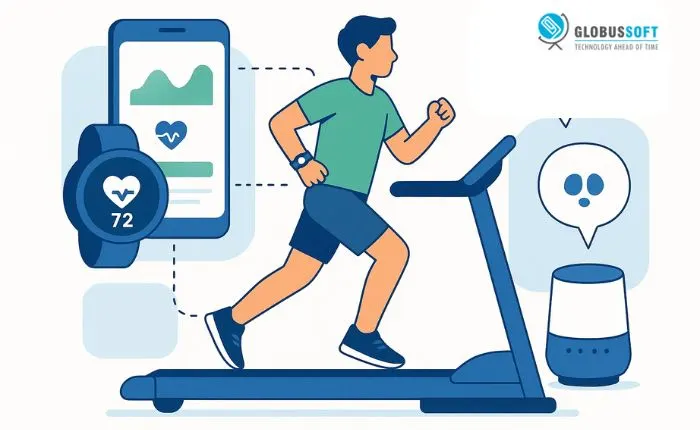
The fitness world has undergone a remarkable transformation, driven by rapid advancements in Emerging AI technology and the rise of FitTech. What was once limited to gym routines and personal trainers has expanded into a thriving digital ecosystem. This fusion of fitness and technology is reshaping how people exercise, monitor progress, and maintain overall well-being.
From AI-powered workout assistants to wearable devices that track every heartbeat, FitTech has made fitness more intelligent and accessible. The movement gained major traction when home-based workouts became the new norm, inspiring millions to explore digital platforms and smart training tools.
Today, this tech-driven approach goes far beyond basic activity tracking. It’s about creating personalised, data-informed fitness experiences that adapt to each individual’s goals and needs. The result is a future where fitness is not only smarter but also more engaging, efficient, and sustainable.
You can listen to this Blog here.
What Is FitTech?
FitTech short for fitness technology refers to the integration of digital tools, artificial intelligence, and smart devices into fitness and wellness routines. It encompasses everything from mobile fitness apps and wearable trackers to AI-driven workout platforms and virtual reality training environments.
The goal of FitTech is simple: to make fitness more personalized, data-driven, and accessible. It empowers individuals to understand their bodies better through metrics like heart rate, calorie burn, and recovery time. For professionals, the FitTech industry provides new opportunities to engage users, design innovative workout programs, and deliver real-time feedback remotely.
With technology evolving rapidly, the boundaries of what FitTech can achieve are expanding fast. From intelligent form correction using computer vision to AI-powered nutrition recommendations, this field continues to push the limits of how people interact with their health.
The Key Technologies Driving FitTech Forward
The FitTech movement thrives on constant innovation. Behind every smart workout app or digital coaching platform are powerful technologies working together to create seamless, personalized fitness experiences. Here are some of the major technologies shaping this evolution:
1. Artificial Intelligence (AI)
AI plays a central role in modern FitTech. From recommending custom workout routines to analyzing performance metrics, AI in FitTech helps users make smarter training decisions. Many platforms now use AI algorithms to track progress, adjust difficulty levels, and even provide real-time feedback during exercises.
2. Wearable Devices
Smartwatches and fitness bands have become the cornerstone of the FitTech industry. These devices continuously monitor heart rate, sleep cycles, and activity levels, helping users gain deeper insights into their health and recovery patterns.
3. Virtual and Augmented Reality (VR & AR)
VR and AR are transforming workouts into immersive experiences. Imagine boxing against a virtual opponent or hiking through digital landscapes—all from the comfort of your living room.
4. Cloud and Mobile Platforms
Cloud connectivity allows seamless data syncing across multiple devices and apps. Users can start a workout on their smartwatch, analyze it on their smartphone, and receive insights on their desktop, creating a truly connected fitness ecosystem.
Together, these technologies are redefining how fitness is experienced, making it more engaging, efficient, and results-driven.
How AI Is Revolutionizing the FitTech Industry?
Artificial intelligence has become the driving force behind the FitTech revolution. It’s not just changing how people train—it’s transforming how fitness data is collected, analyzed, and personalized to meet individual goals.
With the rise of AI fitness technology, platforms can now analyze a user’s performance in real time, adapt workout intensity, and provide instant feedback. This means no more generic routines—each workout is intelligently adjusted based on progress, fatigue levels, and even biometric signals.
AI also plays a key role in predicting performance trends. For instance, machine learning models can detect early signs of burnout or overtraining by studying heart rate variability, sleep quality, and recovery time. This allows users to take preventive steps and optimize their training schedules.
Moreover, AI-driven chatbots and virtual trainers bring the experience of personal coaching directly to users’ devices. They act as digital mentors—motivating, guiding, and educating users on everything from form correction to nutrition.
As generative AI continues to evolve, its applications in FitTech will only expand, introducing smarter workout recommendations, more accurate performance analytics, and deeper health insights.
Benefits of FitTech for Users and Trainers
The growth of FitTech isn’t just about innovation—it’s about improving how people experience fitness. From users striving for personal goals to trainers managing multiple clients, technology brings significant advantages to both sides.
For Users
- Personalized Workouts: With AI-based recommendations, workouts can adapt to each user’s fitness level, preferences, and goals.
- Progress Tracking: Wearables and apps help users visualize their progress with real-time data like steps, heart rate, and calories burned.
- Motivation and Accountability: Gamified challenges, reminders, and social features keep users consistent and engaged.
For Trainers and Coaches
- Data-Driven Insights: The FitTech industry equips trainers with detailed analytics to understand client performance and progress better.
- Remote Coaching Opportunities: Through video training, AI tools, and cloud-based dashboards, trainers can reach clients across the globe.
- Enhanced Efficiency: Automation reduces administrative work—letting professionals focus more on building customized programs.
Ultimately, FitTech bridges the gap between convenience and results, making fitness more interactive and sustainable for everyone involved.
Challenges and Ethical Concerns in FitTech
While FitTech brings innovation and convenience, it also raises important challenges related to privacy, accuracy, and data ethics.
1. Data Privacy and Security
Most FitTech tools collect sensitive health data—like heart rate, location, and sleep patterns. Ensuring this information stays secure and isn’t misused is one of the biggest concerns facing the FitTech industry. Transparent policies and strong encryption are essential for building user trust.
2. Overdependence on Technology
With constant access to tracking tools and digital feedback, users may become overly reliant on devices instead of focusing on how their bodies actually feel. While AI in FitTech enhances training, balance is key to maintaining a healthy relationship with fitness.
3. Algorithmic Bias
AI systems can occasionally misinterpret data due to limited or biased datasets. This can lead to inaccurate recommendations or performance analysis, highlighting the need for continuous improvement and human oversight in AI fitness technology.
4. Ethical Use of AI
As generative AI becomes more capable of creating virtual trainers and synthetic fitness models, questions arise about authenticity and transparency. Users should always know when they’re engaging with AI-generated content.
Despite these challenges, ongoing innovation and responsible technology design can ensure that FitTech continues to empower users safely and effectively.
How Globussoft Is Powering the Next Generation of FitTech Solutions?
The evolution of FitTech is being shaped by smarter, AI-enabled tools—and one standout example is Calorie Tracker Buddy (CTB), a platform developed by Globussoft to make fitness more personalized, engaging, and effortless. CTB uses advanced AI to simplify the way users track food, calories, and daily habits. Logging meals is easy: just snap a photo of your plate, and the app automatically identifies the food items, calculates the calories, and updates your daily intake.
A key highlight of the platform is Buddy, your virtual puppy—who motivates you throughout your fitness journey. Buddy reminds you to log meals, celebrates progress, and reacts to your daily consistency—turning healthy habits into a fun, interactive experience. CTB also functions as a smart step counter. It tracks your daily movement and shows exactly how many calories you burn while walking or running, helping you maintain a clear balance between intake and activity. To keep you on track, the app allows you to monitor weekly and monthly goals, visualize trends, and measure real results over time.
By blending AI-driven insights with playful motivation, Calorie Tracker Buddy demonstrates how Globussoft is contributing to the next generation of FitTech—making wellness simpler, smarter, and more enjoyable for everyone.
Also read,
10 Emerging AI Technologies Transforming The World
The Future of FitTech
The future of FitTech promises to be more intelligent, integrated, and immersive than ever before. As technology continues to evolve, the boundaries between digital wellness and real-world fitness will keep blurring, creating a seamless experience that adapts to each individual’s lifestyle.
Artificial intelligence will remain at the heart of this transformation. With advanced analytics and machine learning, AI fitness technology will soon be able to predict injuries, optimize recovery times, and create fully adaptive workout plans based on biometric data. Meanwhile, generative AI will make it possible to design personalized fitness routines, virtual trainers, and even immersive wellness environments that respond to a user’s energy, stress, or mood in real time.
The FitTech industry will also see stronger collaboration between health, nutrition, and wearable tech companies—leading to more holistic solutions that connect physical activity with overall well-being. This integration will encourage people not just to work out, but to live healthier and more balanced lives.
Ultimately, FitTech isn’t just shaping the future of fitness—it’s redefining what it means to stay healthy in a connected world.
Conclusion
The rise of FitTech marks a defining moment in how we approach health, fitness, and overall wellness. By combining human motivation with the precision of technology, it’s transforming workouts into personalized, data-driven journeys that inspire real, lasting change.
Through the use of AI, wearable devices, and smart applications, FitTech empowers individuals to take control of their fitness like never before. For professionals and brands, it opens doors to scalable, innovative solutions that engage users and deliver measurable results.
Companies like Globussoft exemplify this evolution—creating tools such as Calorie Tracker Buddy (CTB) that make smart fitness accessible to everyone. Their commitment to building AI-powered, user-focused technology shows how the future of fitness lies in collaboration between innovation and empathy.
As technology continues to advance, one thing is certain: FitTech isn’t just a trend—it’s the foundation of the next generation of health and fitness experiences.
- What are the benefits of using FitTech?
FitTech helps users stay consistent, track progress accurately, and stay motivated through data and automation. It also allows trainers and fitness professionals to deliver smarter, more efficient coaching programs. - Is FitTech suitable for beginners?
Yes, absolutely. Most FitTech platforms are designed to guide users of all fitness levels. With AI support and intuitive designs, even beginners can start with simple routines and gradually advance based on their progress. - What’s next for the FitTech industry?
The FitTech industry is heading toward greater integration of AI, wearables, and generative AI solutions. Future tools will focus on holistic wellness, combining fitness, nutrition, and mental health tracking for a more complete lifestyle approach.


